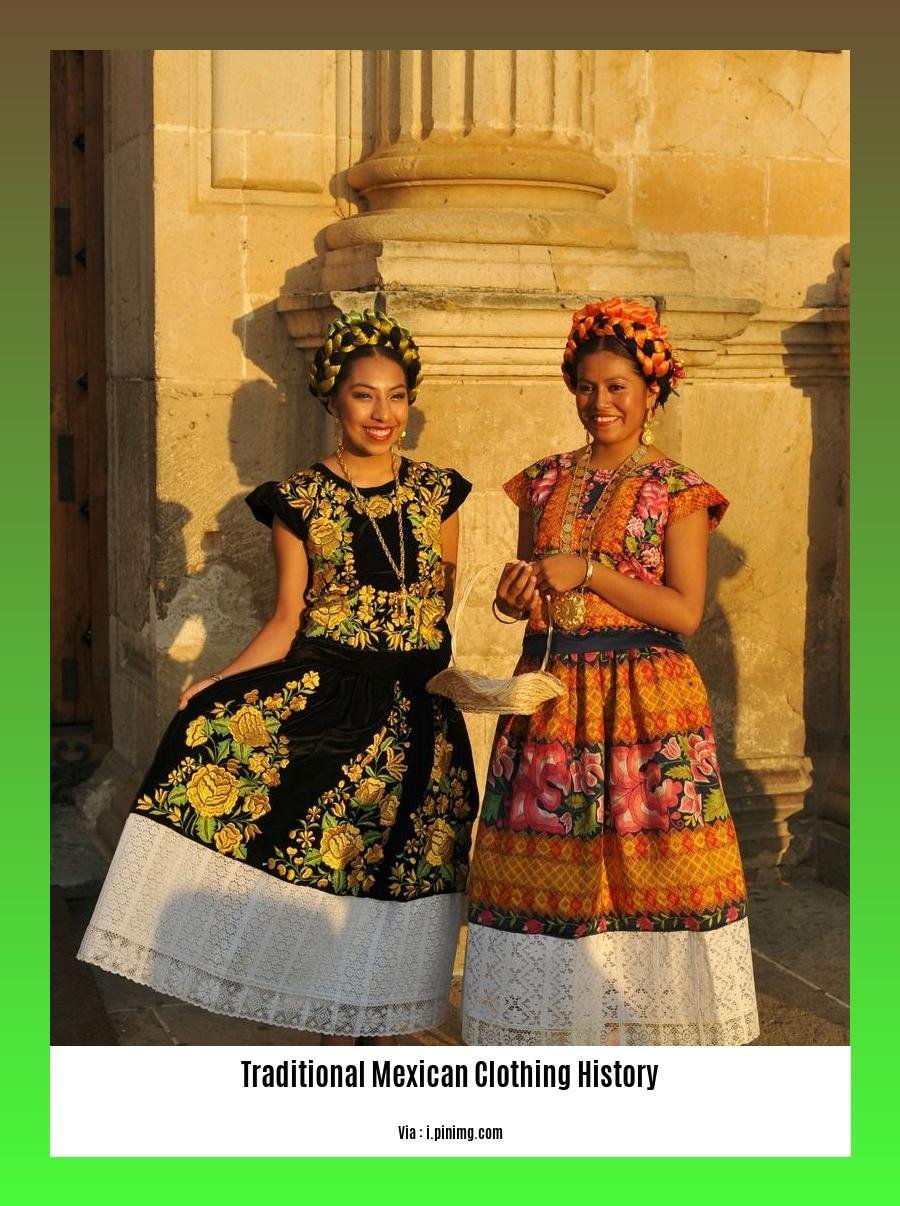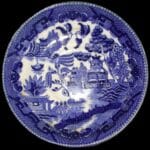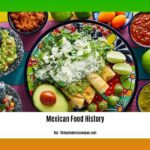Embark on a captivating journey through time as we unveil the rich history of traditional Mexican clothing in our article titled [A Journey Through Time: Unveiling the History of Traditional Mexican Clothing]. Delve into the depths of ancient civilizations, explore the influences of colonial rule, and witness the vibrant evolution of Mexican attire into the vibrant cultural tapestry it is today.
Key Takeaways:
Traditional Mexican textiles have a history that spans approximately 2,500 years.
Initially, fibers for textiles were sourced from plants like yucca, palm, cotton, willow, and maguey.
After the Spanish colonization, new fabrics like wool and silk were introduced, along with the pedal loom.
Traditional Mexican men’s clothing was mainly crafted in neutral colors like greys, blacks, and brown.
Women traditionally wore long skirts that typically reached their ankles.
Modern-day Mexican clothing incorporates a wider array of colors, reflecting a departure from the traditional neutral tones.
Traditional Mexican Clothing History
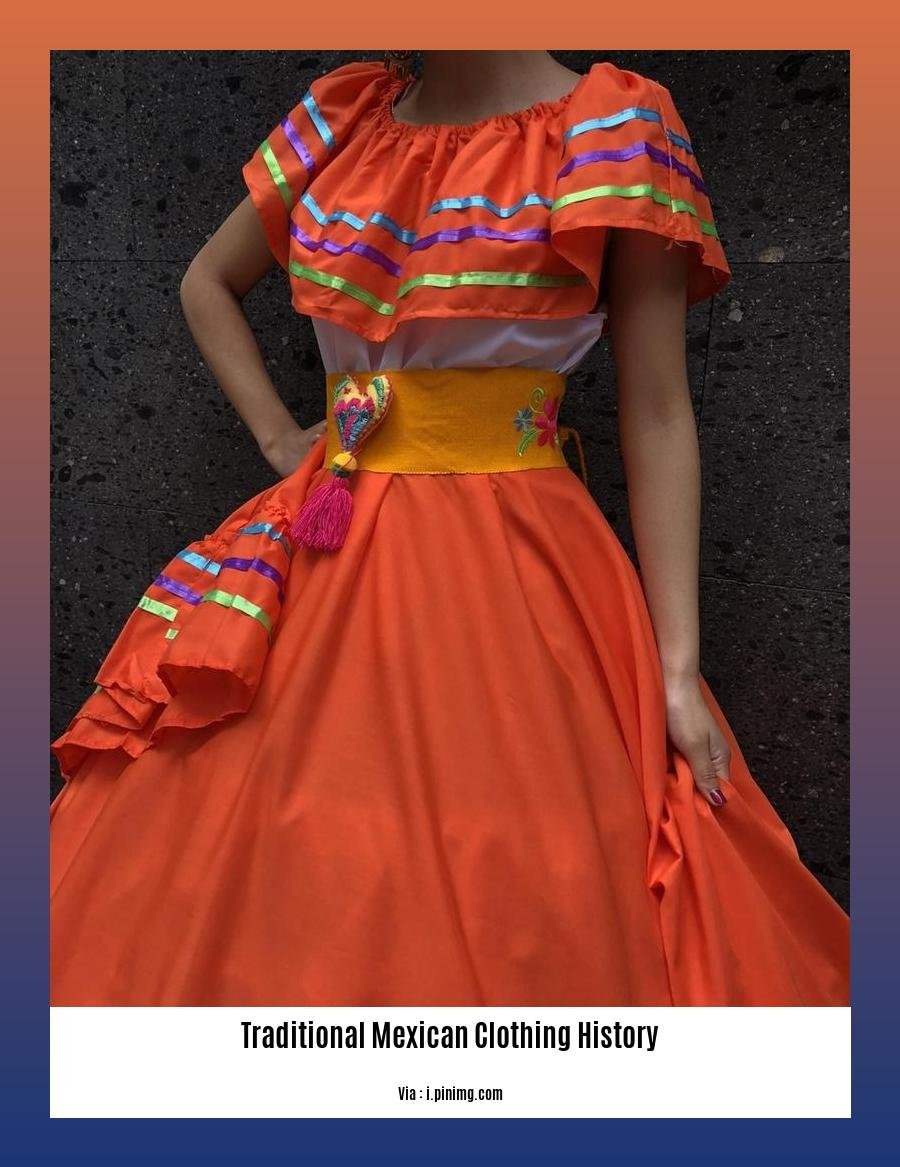
When envisioning traditional Mexican clothing history, we embark on a colorful and vibrant journey that spans millennia, embodying rich cultural traditions and captivating visual narratives. Delving into this realm, we encounter an exquisite tapestry woven with ancient techniques, vibrant colors, and intricate designs.
Origins: A Legacy Rooted in Ancient Civilizations
The history of traditional Mexican clothing dates back to the pre-Columbian era, where indigenous civilizations like the Mayans, Aztecs, and Zapotecs showcased remarkable textile artistry. Clothing served not only for adornment but also held profound cultural significance, representing social status, religious beliefs, and ethnic identity.
Natural Fibers: Honoring the Land’s Abundance
Pre-Hispanic garments predominantly utilized natural fibers derived from plants, such as yucca, palm, cotton, willow, and maguey. These fibers were carefully harvested, spun into yarn, and meticulously transformed into intricate textiles using traditional weaving techniques.
Spanish Influence: A Fusion of Cultures
The arrival of the Spanish in the 16th century introduced new materials and techniques that blended harmoniously with indigenous traditions. Wool and silk, previously unknown in the Americas, were incorporated into traditional Mexican clothing, along with the pedal loom, revolutionizing the textile industry.
Men’s Attire: Understated Elegance
Traditional Mexican attire for men typically featured neutral colors like grays, blacks, and browns. These garments exuded a sense of simplicity and practicality, reflecting the daily lives of the working class.
Women’s Skirts: A Symbol of Grace and Femininity
Women’s skirts, often reaching the ankles, were adorned with vibrant colors and intricate designs. These skirts embodied grace and femininity, showcasing the wearer’s cultural heritage and personal style.
Modern Evolution: Embracing Color and Diversity
In contemporary times, traditional Mexican clothing has undergone a vibrant evolution, incorporating a wider array of colors and styles. This evolution reflects
If you have a taste for history along with food, then you must be wondering about the history of Spanish cuisine. To know more about the history of Spanish food, you should read our blog about Spanish Food History. Similarly, if you are curious to learn about the history of Thai food, then read our article Thai Food History.
Symbolism and Cultural Significance: Colors, Patterns, and Embroidered Designs
In the realm of fashion, colors, patterns, and embroidered designs act as vibrant storytellers, narrating the rich cultural heritage of a region. Nowhere is this more evident than in the traditional attire of Mexico, where each hue, motif, and stitch holds profound symbolic meaning.
Colors: A Visual Symphony of Nature and Emotions
Traditional Mexican clothing is renowned for its vibrant colors, each shade carrying a deep significance that mirrors the diverse elements of nature and the spectrum of human emotions.
- Red: Passion, love, and strength
- Green: Hope, fertility, and new beginnings
- Blue: Water, sky, and tranquility
- Yellow: Sun, joy, and happiness
Beyond these primary hues, traditional Mexican attire features a kaleidoscope of colors, each contributing to the visual symphony that makes it so captivating.
Patterns and Motifs: Symbols of Life and the Natural World
Patterns and motifs in traditional Mexican clothing are not mere embellishments; they are visual narratives that depict symbols of flora and fauna, abstract designs, and traditional stories.
- Floral motifs: Celebrate the beauty and diversity of Mexico’s flora, from delicate roses to majestic sunflowers.
- Animal motifs: Represent the rich fauna of the region, from soaring eagles to majestic jaguars.
- Geometric motifs: Draw inspiration from ancient indigenous cultures, representing harmony and balance.
Embroidered Designs: A Thread of Cultural Identity
Embroidered designs in traditional Mexican clothing are a testament to the skill and artistry of Mexican artisans. These intricate embellishments often depict scenes from everyday life, religious beliefs, and mythological tales, creating a vibrant tapestry of cultural heritage.
- Traditional Mexican blouses: Often feature intricate embroidered designs around the neckline, sleeves, and hem.
- Dresses: Embroidered designs may adorn the skirt, bodice, or both, creating a visually stunning effect.
- Huaraches: Embroidered designs on these traditional sandals add a touch of flair and individuality.
Key Takeaways:
- Traditional Mexican clothing is a vibrant expression of cultural heritage.
- Colors, patterns, and embroidered designs hold deep symbolic meaning.
- Colors represent elements of nature and emotions.
- Patterns and motifs depict flora, fauna, and traditional stories.
- Embroidered designs showcase artisanship and cultural identity.
Sources:
- History of Mexican Clothing: Traditional Styles and Materials
- Understanding Cultural Motifs in Traditional Clothing
Evolution of Traditional Attire: From Pre-Columbian Times to Contemporary Fashion
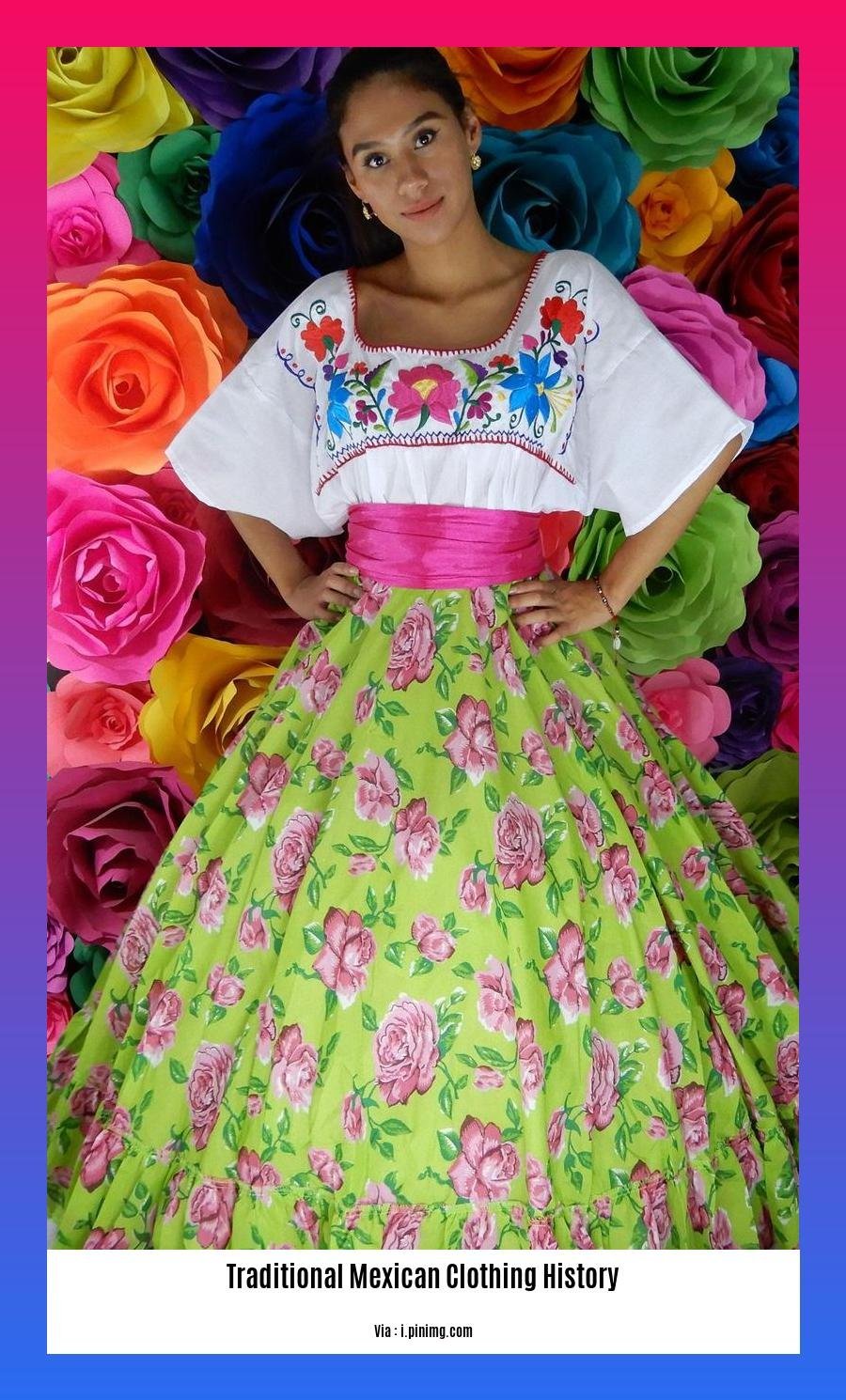
Traditional Mexican attire, a vibrant symphony of colors, patterns, and cultural symbolism, has undergone a fascinating journey through time. Our exploration of this rich heritage reveals how indigenous cultures, colonial influences, and modern trends have shaped the unique identity of Mexican clothing.
Pre-Columbian Roots: A Tapestry of Cultural Expression
Before the arrival of Europeans, diverse Native American societies flourished across the Americas, each with its distinctive clothing traditions. Drawing inspiration from their environment, they crafted garments from natural materials such as cotton, wool, and feathers. These garments served not only practical purposes but were also imbued with symbolic significance, reflecting status, identity, and cultural beliefs.
The intricate weaving, embroidery, and color choices of pre-Columbian textiles showcased the exceptional craftsmanship of Native American artisans. Symbolic motifs and colors, often inspired by nature or religious beliefs, transformed clothing into a powerful form of artistic expression.
Colonial Encounters: Embracing New Influences
The arrival of Spanish colonizers brought about significant changes to Native American clothing practices. The introduction of new materials, such as wool and silk, and techniques, like the pedal loom, transformed textile production. While Native Americans adopted some of these innovations, they skillfully blended them with their traditional designs and motifs, creating a unique fusion of cultural influences.
Modern Transformations: A Reflection of Evolving Identity
In contemporary times, Mexican clothing has continued to evolve, embracing modern trends and reflecting the diverse cultural landscape of the nation. The range of colors and styles has expanded, showcasing the vibrant spirit of Mexican culture.
Traditional garments, often reserved for special occasions, continue to hold cultural significance, representing a deep connection to heritage. However, contemporary fashion has also embraced traditional motifs and textiles, incorporating them into modern designs that resonate with a global audience.
Key Takeaways:
Traditional Mexican attire traces its roots to pre-Columbian civilizations, with each indigenous group expressing cultural heritage and identity through textiles.
Native Americans utilized natural fibers and traditional weaving techniques, creating garments rich in symbolic motifs and colors.
The arrival of Spanish colonizers introduced new materials and techniques, leading to a fusion of cultural influences in Mexican clothing.
Modern times have witnessed a blending of traditional and contemporary styles, with traditional garments reserved for special occasions and traditional motifs incorporated into modern fashion designs.
Mexican clothing remains a vibrant representation of the nation’s cultural diversity, serving as a canvas for both tradition and innovation.
Sources:
- History of Mexican Clothing: Traditional Styles and Materials
- Traditional Mexican Clothing: A Reflection of Cultural Identity
The Role of Artisans and Craftsmanship: Preserving and Promoting Traditional Techniques
In the realm of Mexican cultural heritage, traditional attire stands as a testament to the enduring artistry and craftsmanship of its people. These intricate garments, passed down through generations, embody a rich tapestry of symbols, stories, and techniques that have survived the test of time.
Key Takeaways:
- Artisans play a pivotal role in preserving and promoting traditional techniques, ensuring the continuity of cultural heritage.
- Preserving traditional crafts fosters cultural identity, generates income, and promotes sustainable livelihoods.
- Challenges such as globalization and mass production threaten the survival of traditional craftsmanship.
- Supporting artisans and promoting traditional techniques helps sustain cultural heritage and empowers local communities.
The history of traditional Mexican clothing is deeply intertwined with the diverse indigenous cultures that flourished before colonization. Each garment tells a unique story, reflecting regional traditions, beliefs, and the enduring spirit of the Mexican people.
The arrival of European influences brought new materials, techniques, and designs, resulting in a fusion of cultures that shaped the distinctive style we see today. Traditional attire embodies this blend, showcasing intricate embroidery, vibrant colors, and motifs inspired by nature, history, and everyday life.
Beyond their aesthetic appeal, traditional Mexican garments carry profound cultural significance. Clothing served as a means of communication, conveying social status, marital status, and religious affiliation. It was also an expression of creativity and artistry, with each piece carefully crafted by skilled artisans using time-honored techniques.
In contemporary Mexico, traditional attire continues to thrive, thanks to the dedication of artisans who work tirelessly to preserve and promote their craft. Weaving, embroidery, and other techniques are passed down from generation to generation, ensuring the survival of these cherished traditions.
The Role of Artisans and Craftsmanship: Preserving and Promoting Traditional Techniques
The artisans who create traditional Mexican clothing are the heart and soul of this cultural heritage. Their skilled hands bring to life the intricate designs and vibrant colors that define these garments. Through their dedication and expertise, they not only preserve traditional techniques but also promote the cultural identity of Mexico.
Supporting Artisans and Preserving Heritage
Preserving traditional Mexican attire is not just about safeguarding a collection of garments but about supporting the livelihoods of the artisans who create them. Buying traditional clothing directly from artisans helps sustain their communities and ensures that these skills continue to be passed down to future generations.
Challenges to Traditional Craftsmanship
Globalization and mass production pose significant challenges to the survival of traditional craftsmanship. The influx of inexpensive, machine-made clothing has created a competitive market that often undervalues the time and effort invested in handmade garments. Artisans struggle to compete with these mass-produced items, leading to a decline in demand for traditional clothing.
Despite these challenges, there is a growing movement to support traditional artisans and promote their work. This includes initiatives that provide training and resources to artisans, as well as efforts to educate consumers about the value of handmade goods.
Conclusion
Traditional Mexican clothing is a vibrant expression of cultural identity, history, and craftsmanship. By supporting the artisans who create these garments, we not only preserve a valuable heritage but also contribute to the sustainability of local communities. Every purchase of a traditional Mexican garment is an investment in the preservation of Mexican culture.
References:
- UNESCO – Traditional Craftsmanship
- Youlin Magazine – Preserving Our Traditional Crafts and Craftsmanship
FAQ
Q1: What are the origins of traditional Mexican clothing?
A1: Traditional Mexican textiles can be traced back approximately 2,500 years, with natural fibers like yucca, palm, cotton, willow, and maguey initially used to create garments.
Q2: How did Spanish colonization influence Mexican clothing?
A2: After the Spanish colonization, new fabrics like wool and silk were introduced, along with the pedal loom, which led to changes in traditional clothing styles and techniques.
Q3: What are some distinguishing features of traditional Mexican men’s attire?
A3: Traditional Mexican men’s clothing was predominantly made in neutral colors such as greys, blacks, and brown, often featuring simple and functional designs.
Q4: What is the significance of long skirts in traditional Mexican women’s clothing?
A4: Traditionally, women wore long skirts that typically reached their ankles, as they were considered a symbol of modesty and respect within Mexican culture.
Q5: How has modern fashion influenced contemporary Mexican clothing?
A5: Modern-day Mexican clothing incorporates a wider variety of colors, reflecting a departure from the traditional neutral tones, and often blends traditional designs with contemporary fashion trends.
- China II Review: Delicious Food & Speedy Service - April 17, 2025
- Understand Virginia’s Flag: History & Debate - April 17, 2025
- Explore Long Island’s Map: Unique Regions & Insights - April 17, 2025
